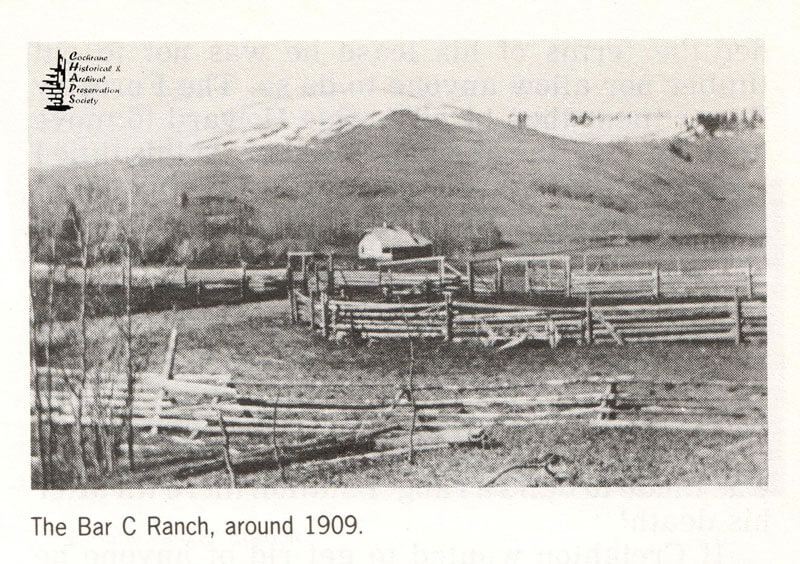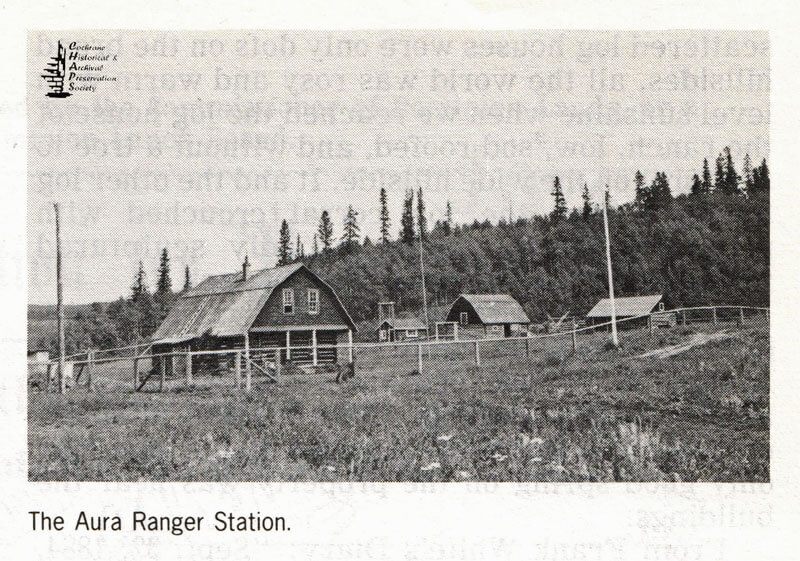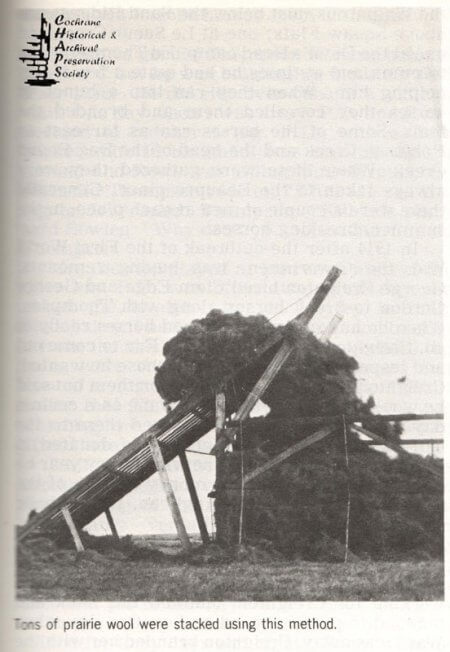by Laurie Johnson
One of the more colourful characters to settle in the Cochrane district was George Creighton, who came West from Ontario, where, in his youth, he had worked on the Ottawa River log drives. He was a generous man and highly patriotic, but, though there is no record of his having injured anyone, he could be fierce when he felt his rights or his territory were being invaded, and he would go to great lengths to scare away those he wanted to get rid of. I did not work for George Creighton but I knew him well, had some dealings with him and found him to be a real gentleman.
He homesteaded the W1, 28-26-5-5 and moved into the cabin built by Beaupré. In 1876 Beaupré had come with his wife and squatted on the land beside the creek which bears his name. He built a little log cabin and a long, low stable. The logs were skillfully dovetailed and the sod roofs were covered with troughed logs. He gathered together a little herd of cattle, but in 1883 he sold out and moved away. Shortly after he left, George Creighton settled on the place.
In the late 1890s, Creighton took horses to the Peace River country and packed for a survey party. It is believed that he went to the Klondike in the gold rush of 1898. After his return he hired Downey, in 1903, to build the large square house that used to stand on the Beaupré Creek Ranch. His second wife died in childbirth, and both she and the babe were buried beside the house. Later they were moved to the Cochrane Cemetery.
Creighton’s great ambition was to own a thousand head of horses. With this in view, he bought the Le Sueur ranch, which, from that time on, has carried the name of Creighton’s brand, the Bar C. The Bar C Ranch was ideally situated and blessedly remote before the building of the Forest Reserve road. In George Creighton’s day, the Eau Claire road had been built south to Morley. The Bar C was almost encircled by creeks and rivers, both the Waiparous Creek and the Ghost River have their source behind Black Rock Mountain which stands guard over Bar C territory. On the Bar C range, Meadow Creek with its many small branches flows into the Waiparous and Le Sueur Creek into the Ghost. The Waiparous joins the Ghost just four miles east of the ranch buildings, and that triangle is known as the Forks field. Besides the deeded land Creighton held some Crown land under lease.
When the Forestry Department sent a man named Flack into Creighton’s territory to build a log ranger station at Aura spring, Creighton burned the cabin and scared the man out of there. He felt justified in doing this because under the terms of his lease he was not to cut timber nor allow anyone to do so. The Forestry Department then hired Archie Howard to move up to Aura spring and build a cabin. At this time I became slightly involved as both sides borrowed weapons from me. Archie Howard knew of Flack’s experience and asked me for my 32 revolver. He said he would need it for protection. Not long after, Creighton came and asked me if I had a 45 with black ammunition. I had just what he wanted – a gun which would make a loud noise and a lot of smoke. When he brought it back to me he said, “It worked!” No further attempt was made to build a ranger station there till after his death!
If Creighton wanted to get rid of anyone he could scare the hell out of them. He never swore, but he would get up in the night and roar around and roll the cylinder of his six-shooter. John, a Russian, who worked for him, was one of his victims. John slept in a little room off the kitchen. When he heard those terrifying sounds in the night he dived through a small window, taking the sash with him. He took off east, running as if the devil were after him. D. P. McDonald used to say that the window sash was still around his neck when he reached the Mount Royal Ranch. D.P. put him to sleep in the bunkhouse, but John insisted that trunks be piled around him where he lay in the corner. He was still afraid that Creighton would come for him.
Mr. Austin, at one-time editor of the Cochrane Advocate, once spent a few days at the Bar C and was forced out of there by Creighton in much the same way. Fearing that he would die before he reached safety, he wrote a note and left it on a tree by Waiparous Creek. The note stated that Creighton was responsible for his death, but he reached the Glenfinnan Ranch safely.
Creighton’s horses never numbered many over 650 head. He kept about ten stallions, Rock, a Thoroughbred, and one, Saxon, was a Coachhorse. He occasionally left a few good colts uncastrated, to roam the range. Each horse had his own territory, more or less. Two might run with their mares in the Forks field. One old stallion, Donald, a Shire by Old Willow, was never brought in from the Devil’s Head camp, summer or winter, till the ranch changed hands. Another bunch ran on Meadow Creek and a couple of bunches up the Waiparous. Drift fences were almost unknown but Creighton did some fencing around the Devil’s Head Camp. (This camp was east of Black Rock and several miles from the Devil’s Head.) Dave McDougall used to push his horses up to this open range so Creighton wanted to build a drift fence there. He hauled some rolls of wire up to the top of the hill, by the old road no longer in use, and left the wire there – about two miles west of Le Sueur Creek. Dave McDougall came along and rolled it all down the hill and into the Ghost River.
Corrals were spotted here and there over the range: one in the Forks field; one on the bank of the Waiparous, just below the Sand Ridges; one above Squaw Flats; one at Le Sueur Creek and one at the Devil’s Head camp. Ed Thompson was a foreman and at times he had quite a few riders helping him. When they ran into a bunch of horses they corralled them and branded the foals. Some of the horses ran as far east as Robinson Creek and the head of the Dog Pound Creek. When these were gathered they were always taken to the Beaupré place. Generally, there were a couple of men at each place, in the summer, breaking horses.
In 1914 after the outbreak of the First World War the Government was buying remounts George Creighton hired Clem Edge and George Gordon to break horses along with Thompson When he had a carload of good horses ready to go, Creighton called up Colonel Fry to come out and inspect them and pick out those he wanted. Creighton refused to put a price on them but said he would deliver them to Cochrane on a certain day. This he did, and he donated them to the Government as his war effort. He donated to every local cause during the war. Every year he gave an equal amount of money to each of the Cochrane churches, the Anglican, the Catholic and the Presbyterian.
The year 1914 brought more tragedy into George Creighton’s life. The trouble all started over a little bay mare. George Ward, who was working for Creighton, claimed this slick and planned to put his brand on her. One day when Ward was away, Creighton branded her with the Bar C. In revenge, Ward reported Creighton for horse stealing. Creighton wanted Paddy Nolan to defend him but they were on the outs, and he was too proud to ask him. So he asked Charlie Grayson to get him a lawyer, knowing that he would get Nolan. In the long-drawn-out trial, Nolan defended him so well that Ward, the only witness, left that part of the country and Creighton was acquitted. The stress and worry were too much for George Creighton and he died in March 1915.
When George Creighton died, his brother, Tom, came from Eastern Canada to take over the ranch. He had been a timber cruiser and admitted that he knew nothing about horses. Ed Thompson hired me to help him break horses and do the other ranch work. We worked together all summer and then Thompson left to visit his brother in the States and I became foreman, Tom’s son, Ernest, came from the East and did his best to help with all the work.
Just one year after George Creighton died, the ranch was sold to P. D. Bowlen. I hired Marshall Baptie and Jack Fuller to help me gather the horses. Later Eddie Rowe came from Saskatchewan to the ranch. Altogether we gathered 650 horses and as fast as they were gathered P. D. Bowlen sold all that was saleable. After the horses were gathered, Eddie Bowlen and I broke horses down at the Beaupré Ranch.
I tried to get Ed Thompson to come back to the Bar C but he was building up the Little Red Deer place. He did ride over once in a while to visit. One day when I was away, P.D. and Rowe decided to butcher a pig. P.D., with a little pocket knife in his hand, was chasing the pig around and Rowe was killing himself laughing when Ed Thompson rode in. “What are you trying to do?” asked Thompson. “Kill this pig!” said Bowlen. “Why don’t you poison him?” said Thompson
Mrs. Bowlen stayed at the ranch most of the time and P.D. was often away. One day she asked me to drive her to Morley in their Studebaker. I had never driven a car so I backed it from the shed into a large paddock where the gates were shut, and I drove it around and around trying to get used to the gears. I didn’t notice that Thompson had ridden in and was watching me, till I heard him yell, “If you’re afraid to take it out why don’t you tie up a leg?”
While I was at the Bar C, Ed Bowlen, P.D.’s brother, came for a visit. He was an engineer on the building of the Panama Canal and was a remarkably versatile man. Ed Thompson showed him how to dovetail the corners of a log building, and, although he was not an axeman, he built the stable which still stands and did an excellent job of the corners.
In the spring and early summer of 1915, it rained for forty days and nights. Boney Thompson and I rode day after day in the rain and for three weeks we were stranded there unable to cross the flooded rivers. I tried to get out over the Le Sueur crossing but my horse rolled over in the swift water. Fortunately, we came out on the same side of the river. This was just after Bowlen bought the ranch.
On three occasions, at least, the Bar C was threatened by fire and much of the range was burned over. Luckily the buildings always escaped. In 1910 a fire came from the south, jumped the Ghost River, Waiparous Creek and the Little Red Deer River and burned the Greasy Plains and beyond. In 1914 a fire was started by lightning up Waiparous Creek. George Creighton, Boney Thompson, Jerry Fuller and his son, Jack, fought this fire and almost had it under control when the wind changed and took it west to Black Rock and south to the Bar Chay meadows. In 1919 a fire started in the Broken Leg Lake country, jumped the Ghost River, where the gravel flats are a quarter of a mile wide, and came so close to the Bar C buildings that P. D. Bowlen took everything out of the house and stacked it in a pile in the big paddock.
In 1912, Brady, a prospector, who had discovered gold in California, caused more excitement when he claimed to have discovered gold on the north bank of the Ghost, just south of the Bar C. Cochrane went wild. Many parties were outfitted there and guided up to the strike. It is estimated that five hundred claims were staked but they only produced fool’s gold.
In 1924 P. D. Bowlen sold the Bar C to Mr. Duncan and his sons, Cecil and Jack. They kept sheep as well as cattle and horses. They branded their horses quarter-circle D, and horses with that brand could still be seen running wild on the Forest Reserve in the 1950s, years after Duncan’s left.
In 1935 they sold the Bar C to Mrs. Merriman and her daughter. By this time more deeded land had been added to the ranch: the Hudson’s Bay Section at the north and some C.P.R. land in the Forks Field. Mrs. Merriman’s grandchildren, Gina and Jack Souther took correspondence courses for a while before continuing their schooling in Calgary. Jack is a geologist and Gina is a talented artist and bronze sculptor. She married Robert McDougall and they have three children, Sally, Robert and Jean.
The ranch has changed hands several times since Mrs. Merriman bought it and it is now owned by Lester Beck.





Enjoyed all the stories. Thought the Bowlen’s still lived in the area till the late
Seventies??